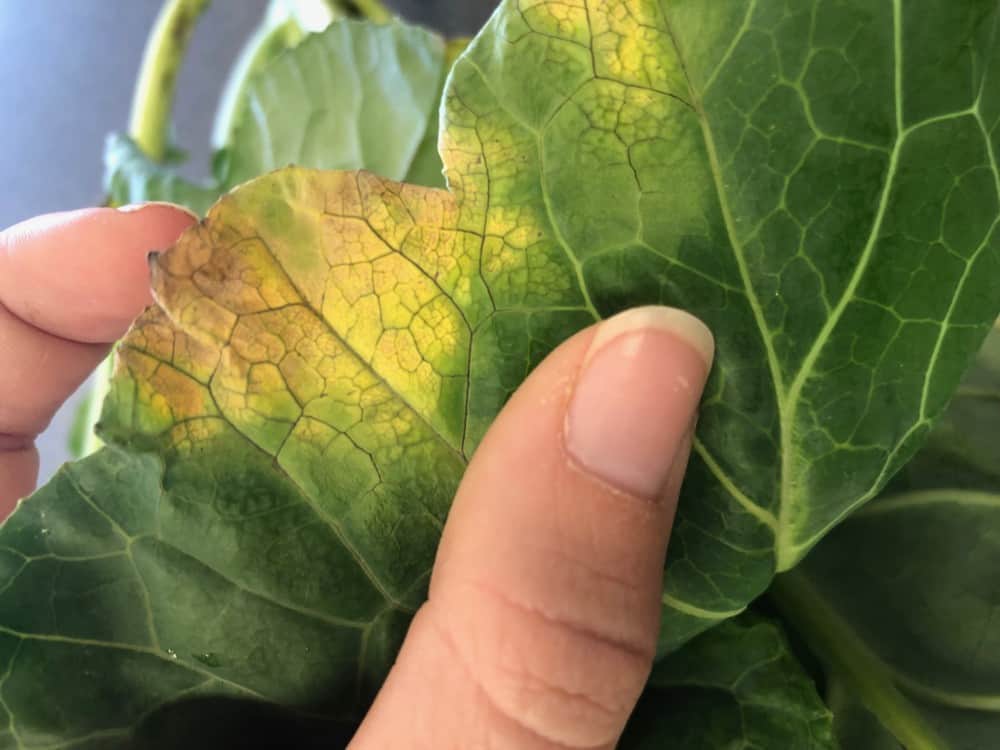Broccoli plant leaves turning yellow is an alarming sight to see among gardeners.
Instead of the deep and lush green hue, yellow leaves are unlikely signs of thriving health in plants.
What can you do if you see this scenario in your crops? Most importantly, what’s causing this issue, anyway?
We uncover the often overlooked reasons why broccoli leaves turn yellow and what you can do to stop it.

Broccoli Plant Leaves Turning Yellow – A Combination of Problems?
A perfect broccoli is green all around – from the head to the stalk and leaves.
This cruciferous is from the same family as the cabbage and cauliflower. It thrives in cooler weather, as long as it receives full sunlight and other elements to support its growth.
So, if you notice the broccoli plant leaves turning yellow, it means only one thing – something is just not right in its environment.
For the most part, broccoli loves a sandy soil that’s rich in nitrogen and with a slight acidity. Unfortunately, there are instances when instead of seeing the leaves looking healthy and green, they turn yellow. What gives?
Here are some issues behind this yellowing concern:
1. Nutrient Deficiency
As I mentioned earlier, broccoli needs nutrients from the soil to thrive.
It needs all the right conditions to nourish it from seedling to maturity. Otherwise, certain problems may arise such as the leaves turning yellow.
Here’s a video about nutrient deficiency and what it does to your crops.
Additionally, there is an issue called nitrogen deficiency that affects broccoli.
Keep in mind that this particular crop is a heavy feeder. Thus, it requires more nitrogen from the soil to thrive.
If you see your broccoli plant leaves turning yellow, it means that it is not receiving sufficient nitrogen. The yellowing begins on the bottom leaves, then it eventually moves upward if the problem persists. Soon, the head turns yellow until the entire plant dies.
2. Unharvested Matured Broccoli
Another reason behind the yellow leaves in broccoli is over-maturation. If you leave your crops unharvested, the heads will soon turn yellow and produce seeds. You will notice the flower buds begin to swell and the head turns bright yellow. This will then cause the flowers to burst as these contain seeds for the next generation of your crops.
Once the broccoli head turns yellow, this impacts the taste, as well. It will taste bitter, unlike the crisp and fresh flavor that green broccoli heads have. Moreover, overly mature broccoli loses its nutritional value.
Read more: When to Plant Broccoli For Fall Harvest
3. Fungal Problems
A broccoli plant may also have yellow leaves when there is a fungal disease present. The culprit is called a Fusarium oxysporum, which is a type of fungus that affects plants. This fungus invades new and older roots. It works its way to the stem until the leaves turn yellow. When left untreated, the leaves fall off and the stems curve as one side becomes stunted.
The worst case scenario with a fungal issue is the death of a plant. It can also affect your other crops, which is a huge concern among farmers and gardeners.
4. Black Rot

This concern among broccoli plants is due to unfavorable temperatures.
Black rot starts with V-shaped yellow lesions found on the leaves. When left unresolved, the leaves will begin to wilt and turn brown. This can also cause the entire plant to die.
This is why it is best to inspect your broccoli plants and look for these black veins. The common areas to look at include the stems, leaves, and petioles. In the case of infected veins, you may also notice a gooey yellowish fluid that comes out of the affected area.
Since broccoli prefers cooler temperatures, black rot is a common issue when you plant this crop in a humid and hot environment.
5. Club Root
Lastly, club root is a problem that causes your broccoli plants’ leaves to turn yellow.
In this case, you may notice the leaves turning a pale yellow color initially. Then, the leaves tend to wilt during the daytime when it is hotter. However, it recovers in the night.
The thing about a club root is that roots end up being swollen. They develop galls or large tumors shaped like spindles. Older plants with this infection do not produce a head, which can also cause them to die later on.
This is a common concern when the soil is very acidic and has a lower pH level than normal.
How to Address Yellowing Concerns with Broccoli Plants
It can be distressing to see your broccoli plants’ leaves turning yellow.
Thus, if you notice this problem right at the start, you need to take action immediately.
There are only a few things that broccoli prefers to grow well – the right soil acidity, ample nutrients, and a favorable temperature. If you have all of these things checked off, you are at a good spot with your crops.
Fortunately, you can easily address the issue with yellowing if the cause is a nitrogen deficiency.
You can add some fertilizer rich in nitrogen once you see the main head starts to develop. Placing your crops in a cooler environment that is not soaked wet is also beneficial to their growth.
However, a yellowing caused by a fungus can be hard to address. Once the infection is present, the only thing you can do is to prevent the other crops from being impacted by this fungus.
In the case of black rot, you can consider moving your crops in a different location. If space is an issue at home or in your yard, it is viable to grow your broccoli in containers. This also provides mobility, allowing you to move the crops to a better temperature ideal for their growth.
Final Words
Broccoli is a challenging crop to plant and care for because of certain diseases that can impact its growth and development.
However, by being aware of the cause behind broccoli plant leaves turning yellow, you can prevent the problem from happening. These tips can guide you on how to care for your crops better to achieve greater yields for higher returns on your investment.